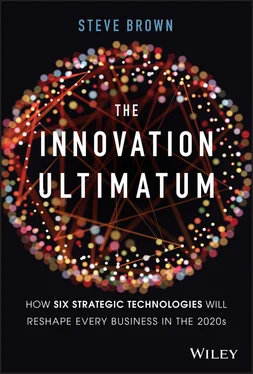Simplish uses AI to convert complex text, with a vocabulary of more than 100,000 words, into simpler text with a vocabulary of less than 2,000 words. NLG will make complex language accessible to broader audiences with lower levels of education, for example, an academic text translated for lay people or children. Future NLP applications might provide comprehensive copyediting services or disrupt the businesses of companies like CliffsNotes.
Quillionz uses AI to automatically generate questions, quizzes, and assessments from a body of text. This provides an amazing aid for teachers, who can guide the AI to focus on particular keyword topics and automatically create multiple-choice questions.
There is a dark side to NLG technology. If we think that online fake news is a problem now, just wait until next-generation NLG is unleashed by the Russian troll farms. A human troll farm might create a hundred fake “news” articles in a day; a weaponized AI could pump out a million pieces of disinformation in a single hour. OpenAI claims to have created NLG software that writes such high-quality text that they have chosen to withhold its release, based on such concerns.
A 2015 survey of 352 leading AI experts by the University of Oxford predicted that AI will translate languages better than human translators by 2024, will write high-school-level essays by 2026, but won't write a best-selling novel until 2049. It's a giant leap from teenage essays to Tolkein, but the direction is clear. While we are a long way from the first Pulitzer Prize–winning novel written by AI, sophisticated NLG technology will soon create complex documents that rival human output.
Voice agents like Apple Siri, Microsoft Cortana, Amazon Alexa, Samsung Bixby, and Google Assistant improve significantly every year. Some add new capabilities almost every week. Google claims their voice assistant is now available on more than a billion devices. These “conversational computing” or “digital dialogue” platforms will reshape the way we work and become an increasingly important part of our lives. Paradoxically, voice agents may become both our managers, and our subordinates, guiding our actions and performing our errands.
Voice interfaces are an important component of hands-free computing and a natural complement to augmented reality. Hands-free technology offers the prospect of “computing for the rest of us” and voice interfaces are valuable for people with impaired vision, for use in sterile clinical environments where physical interfaces aren't appropriate, and for the 80% of people who either work with their hands or in highly mobile environments.
Artificial intelligence—in the form of speech-to-text, NLU, NLG, and speech synthesis—underpins the operation of voice platforms. Continued advances in AI will make conversational computing sound more human. Future voice agents will engage in complex back-and-forth conversations, speak realistically, use human idioms, and even add fake breathing sounds and natural hesitations and pauses to make them sound more human. Google's Duplex technology and Microsoft Cortana have already made great strides and we should expect major breakthroughs in this area in the coming years.
As voice agents become more sophisticated, they will become ever-present in our lives and help us navigate our days. We will use them to make reservations, manage our calendars, run errands, place orders, troubleshoot problems, give advice, and even provide emotional support. Ultimately, a transactional conversation with a digital voice agent will become indistinguishable from one held with a human. This prospect has profound implications for those that work in customer service.
Exploration and Discovery
The New York Police Department (NYPD) uses PATTERNIZR, an AI-based discovery tool, to spot crime patterns. With more than 68,000 robberies, larcenies, and burglaries occurring in New York in 2018 alone, the NYPD will take all the help they can get. The NYPD is split into 77 separate precincts. PATTERNIZR, rolled out in December 2016 but only revealed to the public in early 2019, looks for crime patterns that span precincts. PATTERNIZR frees up human analysts to focus on more complex analysis tasks. Just like a human analyst, PATTERNIZR compares factors including method of entry, the type of items stolen, the distance between crimes, and so on. To eliminate racial bias, the system is not given the race of suspects. PATTERNIZR has already proven useful. For example, the AI found a link between crimes that spanned precincts that had not previously been flagged as connected. In two cases, a man used the threat of a syringe to steal a drill. The AI identified two other instances where a syringe was used as a threat in robberies. The NYPD used the information to locate the suspect and arrest him. He pleaded guilty to larceny and assault.
AI's predictive capabilities are a powerful tool for researchers. Material scientists use AI to predict the structures of materials that may have a desired set of physical properties. New alloys and compounds may be discovered as a result. AI-guided research could lead to the discovery and synthesis of new wonder materials such as room-temperature superconductors and high-efficiency battery electrolytes that would transform the energy sector and help to address the climate challenge. As we review in Chapter 10, pharmaceutical companies use a similar approach to help them discover new drugs. Predictive AI may help us discover therapeutic drugs that transform human health. How might AI boost your company's research efforts?
Better-Informed Decision-Making
Business analytics refine data to offer all manner of insights. Some use statistical techniques, some use heuristics, and many now leverage the power of AI to find associations in data, extract insights, and make recommendations. Intelligent decision support systems use such analytics to support data-driven decision-making. Credit agencies like Experian and credit card companies including American Express use machine learning to boost the speed and accuracy of credit approvals by crunching terabytes of consumer data. Some Customer Relationship Management (CRM) platforms use AI to intelligently prioritize leads. AI is used to guide recruitment decisions, spending decisions, investment decisions, purchase decisions, marketing decisions, design decisions, engineering decisions, and much more.
Mortgage companies use AI to assess loan risk and guide underwriting decisions. Underwriters make the near-Shakespearean decision of “to loan, or not to loan” with risk models built on historical data. An underwriter assesses risk using 10 to 15 data points about a prospective borrower: salary, credit score, debt-to-earnings ratio, and so on. Based on this assessment, the underwriter either gives the thumbs up or thumbs down. Limited data doesn't provide a full picture of a person's ability to repay a loan. There's more to a person than 10 to 15 data points. Underwriters use this narrow data set to limit complexity and manage their workload. An underwriting AI considers hundreds of data points about a person and finds complex associations that create a more nuanced picture of a prospective borrower. Zest Finance and Underwriter.ai claim their underwriting AIs find low-risk loan candidates who don't qualify with a traditional underwriting approach. The upside for mortgage companies: they sell more loans without increasing their risk.
AI offers us a crystal ball. When AI is applied to historical data, it finds patterns and complex associations that allow it to make high-quality predictions about what might happen next. AIs are used to predict disease outbreaks, assess actuarial risk, and predict future demand on the electric grid. Atidot, Quantemplate, and Analyze Re use AI to predict insurance risk.
Читать дальше












